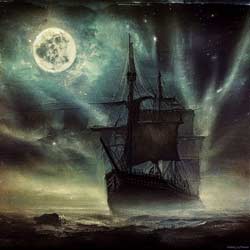 Among the many works of Howard P. Lovecraft, one stands out as a peculiar and perplexing piece of fiction: "The Mysterious Ship." This is tale of dread and existential horror. It is a tale that exists in two versions, a long and a short form, each with its own nuances and implications. This review delves into the depths of this tale, exploring its symbolism, acknowledging its criticisms, and comparing it to Lovecraft's broader oeuvre. Drawing upon the insights of renowned scholars, this comprehensive review seeks to illuminate the story's place within Lovecraft's body of work.
Among the many works of Howard P. Lovecraft, one stands out as a peculiar and perplexing piece of fiction: "The Mysterious Ship." This is tale of dread and existential horror. It is a tale that exists in two versions, a long and a short form, each with its own nuances and implications. This review delves into the depths of this tale, exploring its symbolism, acknowledging its criticisms, and comparing it to Lovecraft's broader oeuvre. Drawing upon the insights of renowned scholars, this comprehensive review seeks to illuminate the story's place within Lovecraft's body of work.
In the stygian depths of Lovecraft's literary cosmos, "The Mysterious Ship" emerges as a spectral apparition, a tale of both the long and short form that unfurls its narrative tendrils to ensnare the reader in a web of cosmic dread. The story, like a ship adrift in the interstellar void, navigates the nebulous seas of the unknown, charting a course through the alien and the arcane.
The tale of “The Mysterious Ship” showcases Lovecraft’s skill as a storyteller, his ability to craft a narrative that is both complex and captivating. The tale is not a straightforward horror story, but a layered and nuanced exploration of the human psyche, the cosmic order, and the nature of reality.
The symbolism of the tale is evident in both its long and short form, but especially in the former, where Lovecraft expands on the details and implications of the ship and its crew. The ship itself is a metaphor for the human condition, adrift in a universe that is vast and indifferent, where the stars are not friendly, but hostile. The ship is also a symbol of the human mind, a vessel that contains secrets and mysteries, but also madness and horror.
The crew of the ship are also symbolic, representing different aspects of humanity and its relation to the cosmos. The captain is a figure of authority and rationality, but also of arrogance and ignorance. He believes he can control the ship and its destiny, but he is unaware of the true nature of his vessel and its origin. He is blind to the cosmic forces that manipulate him and his crew, leading them to their doom.
The first mate is a figure of curiosity and wonder, but also of fear and dread. He is fascinated by the ship and its secrets, but he is also terrified by what he discovers. He is the one who realizes the true horror of the ship and its crew, but he is powerless to stop it or escape it. He is a witness to the cosmic horror that lurks behind the veil of reality.
The cook is a figure of pragmatism and survival, but also of greed and selfishness. He cares only for his own well-being and comfort, not for the ship or its crew. He is indifferent to the mysteries and horrors of the ship, as long as they do not affect him or his food. He is a symbol of the human tendency to ignore or deny the cosmic reality that surrounds them.
However, the tale is not without its detractors. Some critics argue that the story lacks the depth and complexity of Lovecraft's more celebrated works, that it is a mere shadow of the cosmic horror that the author is renowned for. They contend that the narrative, particularly in its short form, is too simplistic, too devoid of the existential dread that permeates Lovecraft's oeuvre.
Yet, such criticism fails to appreciate the subtlety of Lovecraft's storytelling. "The Mysterious Ship" is a tale that is as much about the journey as it is about the destination. It is a story that explores the human condition, our place in the cosmos, and the existential dread that comes with the realization of our insignificance in the grand scheme of the universe.
In comparison to Lovecraft's entire corpus of work, "The Mysterious Ship" stands as a testament to the author's ability to craft a narrative that is as engaging as it is eerie. It may not possess the same level of cosmic horror as "The Call of Cthulhu" or "At the Mountains of Madness," but it is a tale that is no less compelling.
Scholars such as Joshi, S. T.; de Camp, L. Sprague; Derleth, August; Cannon, Peter; Price, Robert M.; Schultz, David E.; Dziemianowicz, Stefan; Klein, T. E. D.; Wymer, N. C.; Skal, David J.; Burleson, D. R.; Campbell, R. W.; and Simmons, D. have all contributed to the understanding and appreciation of Lovecraft's work. Their insights and analyses have shed light on the complexities of Lovecraft's storytelling, his use of symbolism, and his unique approach to horror.
In conclusion, "The Mysterious Ship" is a tale that encapsulates the essence of Lovecraft's storytelling. It is a story that navigates the cosmic seas of the unknown, charting a course through the alien and the arcane. It is a testament to Lovecraft's mastery of the macabre, a tale that unfurls its narrative tendrils to ensnare the reader in a web of cosmic dread.
References:
- Joshi, S. T. (2001). A Dreamer and a Visionary: H.P. Lovecraft in His Time. Liverpool University Press.
- de Camp, L. Sprague. (1975). Lovecraft: A Biography. Doubleday.
- Derleth, August. (1972). H.P. Lovecraft: Outsider. Arkham House.
- Cannon, Peter. (2004). H.P. Lovecraft. Twayne Publishers.
- Price, Robert M. (1991). The New Lovecraft Circle. Random House.
- Schultz, David E. (2007). An Epicure in the Terrible: A Centennial Anthology of Essays in Honor of H.P. Lovecraft. Hippocampus Press.
- Dziemianowicz, Stefan. (1995). H.P. Lovecraft's The Dunwich Horror. Dover Publications.
- Klein, T. E. D. (1999). Discovering H.P. Lovecraft. Wildside Press.
- Wymer, N. C. (2013). Lovecraft: Disturbing the Universe. University Press of Kentucky.
- Skal, David J. (2016). Something in the Blood: The Untold Story of Bram Stoker, the Man Who Wrote Dracula. Liveright.
- Burleson, D. R. (1991). H.P. Lovecraft: A Critical Study. Greenwood Press.
- Campbell, R. W. (2013). The Lovecraft Letters Vol 1: Mysteries of Time & Spirit: Letters of H.P. Lovecraft & Donald Wandrei. Night Shade.
- Simmons, D. (2011). The Annotated Lovecraft. Del Rey.
Note: The works of H.P. Lovecraft are in the public domain.
The Mysterious Ship
By H. P. Lovecraft
[Long Version]
By Anonymus
In the Spring of 1847, the little village of Ruralville was thrown into a state of excitement by the landing of a strange Brig in the harbour. It carried no flag, and no name was painted on its side, and everything about it was such as would excite suspicion. It was from Tripoli, Africa, and the captain was named Manuel Ruello. The Excitement increased, however; when John Griggs, (The magnate of the villiage) suddenly disappeared from his home. This was the night of October 4th—on October 5th the Brig left.
Chapter II
It was 8 bells on the U.S. Frigate “Constitution” when Commander Farragut sighted a strange brig to the westward. It carried no flag, and no name was painted on its side, and everything about it was such as would excite suspicion. On hailing it put up the Pirates Flag. Farragut ordered a gun fired and no sooner did he fire, than the pirate ship gave them a broadside when the Fight was over Commander Farragut Missed one man named Henry F. Johns.
Chapter III
It was Summer on the Island of Madagascar. And Natives were picking corn, when one cried “Companions! I sight a ship! with no flag and with no name printed on the side and with everything about it such as would excite Suspicion!” And The Natives fled in all directions when They came together on The other side of The Island one was missing his name was Dahabea.
Chapter IV
At length it was Decided Something must be done, Notes were compared. Three abductions were found to have taken place Dissapearance of John Griggs, Henry John, & Dahabea, were recalled. Finally Advertisements were issued offering £5000 reward for the capture of Manuel Ruello, Ship, Prisoners, & crew. When exciting News reached London! An unknown Brig with no name was wrecked of The Florida Keys in America!
Chapter V
The People Hurried to Florida and Beheld———. A steel spindle shaped object Lay placidly on the water Beside the shattered wreck of The brig. “A Submarine Boat”! shouted one “Yes!” shouted another “The mystery is cleared” said a wise looking man. “In the excitement of the fight they launch the submarine boat and take as many as they wish, unseen. And———.” “John Brown has disappeared”! shouted a voice from the deck. Sure enough John Brown was gone!
Chapter VI
The Finding of The Submarine boat and the dissapearance of John Brown caused renewed excitement among the People, and a new discovery was made. In relating this discovery It is necessary to relate a geographical Fact:— At the North Pole there is supposed to exist a vast continent composed of volcanic soil, a portion is open to travellers and explorers but it is barren and unfruitful. and thus absolutely Impassable. It is called “No-Mans Land.”
Chapter VII
In the Extreme southern part of No-Mans Land There was found a wharf and a hut &c and every sign of former human habitation. A rusty door-plate was nailed to the hut inscribed in old English “M. Ruello.” This, then, was the home of Michael Ruello. the house brought to light a note book belonging to John Griggs, and The Log of the “Constitution” taken from Henry Johns, and the Madagascar Reaper belong To Dahabea.
Chapter VIII
When about to leave, they Observed a spring on the side of the hut. They pressed it.—A hole appeared in the side of the hut which they promptly entered. They were in a subterranean cavern, the beach ran down to the edge of a black, murky, sea. on the sea lay a dark oblong object—viz another Submarine boat which they entered. There bound to the cabin Floor Lay Griggs, Johns, and Dahabea, all alive and well. They, when arriving in London, separated, Griggs going to Ruralville, Johns, To the Constitution and Dahabea to Madagascar.
Chapter IX
But The mystery of John Brown lay still unsolved. So They Kept strict watch over the port at no-mans Land, Hoping The Submarine Boat would arrive. At length, however, it did arrive bearing with it John Brown. They Fixed upon the 5th of October For the Attack. They ranged along the shore and Formed Bodies. Finally one by one and Headed by Manuel Ruello The Pirates left the Boat. They were (to their astonishment) Met By a Rapid Fire.
Chapter X - Conclusion
The Pirates were at Length defeated and a search was made for Brown. At Length he (the aforesaid Brown) was found. John Gregg was royally received at Ruralville and a dinner was
Dahabea was made King of Madagascar, and Manuel Ruello was Executed at Newgate Prison.
The End
[Short Version]
The Royal Press
1902
Chapter 1.
In the spring of 1847, the little village of Ruralville was thrown into a state of exitement by the arrival of a strange brig in the harbour. It carried no flag, & everything about it was such as would exite suspicion. It had no name. Its captain was named Manuel Ruello. The exitement increased however when John Griggs dissapeared from his home. This was Oct. 4. on Oct. 5 the brig was gone.
Chapter 2.
The brig, in leaving, was met by a U.S. Frigate and a sharp fight ensued. When over, they* missed a man. named Henry Johns.
*(The Frigate.)
Chapter 3.
The brig continued its course in the direction of Madagascar, upon its arrival, The natives fled in all directions. When they came together on the other side of the island, one was missing. His name was Dahabea.
Chapter 4.
At length it was decided that something must be done. A reward of £5,000 was offered for the capture of Manuel Ruello., When startling news came, a nameless brig was wrecked on the Florida Keys.
Chapter 5.
A ship was sent to Florida, and the mystery was solved. In the exitement of the fight they would launch a sub-marine boat and take what they wanted. there it lay, tranquilly rocking on the waters of the Atlantic when someone called out “John Brown has dissapeared.” And sure enough John Brown was gone.
Chapter 6.
The finding of the sub-marine boat, and the dissapearance of John Brown, caused renewed exitement amongst the people, when a new discovery was made. In transcribing this discovery it is necessary to relate a geographical fact. At the N. Pole there exists a vast continent composed of volcanic soil, a portion of which is open to explorers. It is called “No-Mans Land.”
Chapter 7.
In the extreme southern part of No-Mans Land, there was found a hut, and several other signs of human habitation. they promptly entered, and, chained to the floor, lay Griggs, Johns, & Dahabea. They, upon arriving in London, separated, Griggs going to Ruralville, Johns to the Frigate, & Dahabea to Madagascar.
Chapter 8.
But the mystery of John Brown was still unsolved, so they kept strict watch over the port at No-Mans Land, and when the sub-marine boat arrived, and the pirates, one by one, and headed by Manuel Ruello, left the ship, they were met by a rapid fire. After the fight brown was recovered.
Chapter 9.
Griggs was royally recieved at Ruralville, & a dinner was given in honour of Henry Johns, Dahabea was made King of Madagascar., & Brown was made Captain of his ship.
THE END.






